Do you have a question about the Miele KFN 12924 SD-1 and is the answer not in the manual?
Details the functions of buttons and displays on the appliance's control panel for operation.
Identifies and illustrates the various internal parts and storage areas of the refrigerator and freezer.
Provides guidance on environmentally friendly disposal of packaging and the old appliance.
Covers overall safety compliance, intended use, limitations, and child safety precautions.
Details electrical safety, coolant hazards, installation requirements, and safe room specifications.
Lists precautions for correct use, food storage, handling frozen items, and operating internal equipment.
Advises on cleaning stainless steel surfaces and the safe disposal procedure for old appliances.
Optimizing placement and temperature settings for reduced energy consumption.
Tips for economical operation, proper food storage, and effective defrosting to save energy.
Instructions for initial cleaning and removing protective foil before operating the appliance.
Procedures for switching off the appliance, individual sections, and preparing for longer periods of non-use.
Specifies optimal temperature ranges for the refrigerator and freezer sections for food preservation.
Explains how to use the temperature buttons to set the desired temperature for each section.
Describes temperature indicators, acceptable adjustment ranges, and potential flashing light signals.
Explains normal temperature variations and when to check frozen food for defrosting.
Details how temperature alarms and door alarms function, including causes and indicators.
Provides instructions on how to temporarily silence the alarm if it is disruptive.
Guides on when to use Super Freeze for quick freezing and how to activate it.
Explains automatic shut-off and manual deactivation of the Super Freeze function for energy saving.
Explains how Dynamic Cooling ensures even temperature distribution and when it should be used.
Details how to deactivate the Dynamic Cooling function and its automatic shut-off when the door opens.
Explains temperature zones, best practices for storing different foods, and avoiding overcrowding.
Lists fruits, vegetables, and cheeses that are sensitive to cold and should not be stored in the refrigerator.
Guidance on unwrapped meat storage for air circulation and handling protein-rich foods that spoil faster.
Instructions for adjusting shelf height, fitting stoppers, and reconfiguring split shelves for tall items.
Guidance on repositioning door shelves and bottle racks for optimal storage.
Details on respecting maximum freezing capacity and best practices for freezing fresh food quickly.
Advice on checking packaging, use-by dates, and proper storage of purchased frozen items.
Tips for suitable and unsuitable foods, blanching, packing methods, and labeling for home freezing.
Guidelines for placing food correctly in drawers and on cold plates, including handling large items.
Explains various defrosting methods and emphasizes food hygiene rules, especially for poultry and meat.
Instructions for making ice cubes and precautions for quickly cooling drinks in the freezer.
Describes the automatic defrosting process for both refrigerator and freezer sections.
Lists cleaning agents to avoid and procedures for preparing the appliance before cleaning.
Instructions for removing shelves, compartments, and other parts for thorough cleaning.
Details on cleaning the appliance interior, accessories, doors, and side panels with appropriate methods.
Covers cleaning stainless steel doors, ventilation gaps, the compressor area, and door seals.
Addresses issues with the appliance not getting cool, including checking power, fuses, and temperature settings.
Covers problems with temperatures being too low or too high, and frequent compressor cycling.
Addresses food freezing together, door opening issues, alarm sounds, and lighting problems.
Covers issues with a wet refrigerator floor, blocked drain holes, and general fault resolution.
Explains common appliance noises and provides solutions for easily rectifiable rattling or vibrating sounds.
Provides contact information for service, notes on call-out charges, and how to activate the appliance guarantee.
Details UK-specific electrical connection requirements, plug safety, and warnings against extension leads and energy savers.
Guidance on selecting a dry, well-ventilated room, avoiding direct sunlight and heat sources.
Details appliance climate ranges, the importance of ventilation gaps, and dusting requirements.
Steps for removing cable clips, ensuring clearance, pushing the appliance into place, and aligning feet.
Provides detailed measurements for different appliance models, including height, width, and depth.
Step-by-step instructions for safely removing the appliance's door handles.
Detailed instructions for safely removing the upper door, including hinge plate and cover removal.
Instructions for safely removing the lower door, including hinge pin, cover, and spring clamp.
Guidance on re-fitting hinge plates, adjustable feet, and covers for the new hinge orientation.
Instructions for fitting hinge pins, doors, and covers, ensuring proper alignment and securing.
Steps for correctly refitting door handles, ensuring no contact with the door seal and proper alignment.
Instructions for aligning both the lower and upper appliance doors using hinge plate slots and screws.
Details ventilation gaps, air circulation requirements, and clearance for doors and handles in kitchen installations.
Details the functions of buttons and displays on the appliance's control panel for operation.
Identifies and illustrates the various internal parts and storage areas of the refrigerator and freezer.
Provides guidance on environmentally friendly disposal of packaging and the old appliance.
Covers overall safety compliance, intended use, limitations, and child safety precautions.
Details electrical safety, coolant hazards, installation requirements, and safe room specifications.
Lists precautions for correct use, food storage, handling frozen items, and operating internal equipment.
Advises on cleaning stainless steel surfaces and the safe disposal procedure for old appliances.
Optimizing placement and temperature settings for reduced energy consumption.
Tips for economical operation, proper food storage, and effective defrosting to save energy.
Instructions for initial cleaning and removing protective foil before operating the appliance.
Procedures for switching off the appliance, individual sections, and preparing for longer periods of non-use.
Specifies optimal temperature ranges for the refrigerator and freezer sections for food preservation.
Explains how to use the temperature buttons to set the desired temperature for each section.
Describes temperature indicators, acceptable adjustment ranges, and potential flashing light signals.
Explains normal temperature variations and when to check frozen food for defrosting.
Details how temperature alarms and door alarms function, including causes and indicators.
Provides instructions on how to temporarily silence the alarm if it is disruptive.
Guides on when to use Super Freeze for quick freezing and how to activate it.
Explains automatic shut-off and manual deactivation of the Super Freeze function for energy saving.
Explains how Dynamic Cooling ensures even temperature distribution and when it should be used.
Details how to deactivate the Dynamic Cooling function and its automatic shut-off when the door opens.
Explains temperature zones, best practices for storing different foods, and avoiding overcrowding.
Lists fruits, vegetables, and cheeses that are sensitive to cold and should not be stored in the refrigerator.
Guidance on unwrapped meat storage for air circulation and handling protein-rich foods that spoil faster.
Instructions for adjusting shelf height, fitting stoppers, and reconfiguring split shelves for tall items.
Guidance on repositioning door shelves and bottle racks for optimal storage.
Details on respecting maximum freezing capacity and best practices for freezing fresh food quickly.
Advice on checking packaging, use-by dates, and proper storage of purchased frozen items.
Tips for suitable and unsuitable foods, blanching, packing methods, and labeling for home freezing.
Guidelines for placing food correctly in drawers and on cold plates, including handling large items.
Explains various defrosting methods and emphasizes food hygiene rules, especially for poultry and meat.
Instructions for making ice cubes and precautions for quickly cooling drinks in the freezer.
Describes the automatic defrosting process for both refrigerator and freezer sections.
Lists cleaning agents to avoid and procedures for preparing the appliance before cleaning.
Instructions for removing shelves, compartments, and other parts for thorough cleaning.
Details on cleaning the appliance interior, accessories, doors, and side panels with appropriate methods.
Covers cleaning stainless steel doors, ventilation gaps, the compressor area, and door seals.
Addresses issues with the appliance not getting cool, including checking power, fuses, and temperature settings.
Covers problems with temperatures being too low or too high, and frequent compressor cycling.
Addresses food freezing together, door opening issues, alarm sounds, and lighting problems.
Covers issues with a wet refrigerator floor, blocked drain holes, and general fault resolution.
Explains common appliance noises and provides solutions for easily rectifiable rattling or vibrating sounds.
Provides contact information for service, notes on call-out charges, and how to activate the appliance guarantee.
Details UK-specific electrical connection requirements, plug safety, and warnings against extension leads and energy savers.
Guidance on selecting a dry, well-ventilated room, avoiding direct sunlight and heat sources.
Details appliance climate ranges, the importance of ventilation gaps, and dusting requirements.
Steps for removing cable clips, ensuring clearance, pushing the appliance into place, and aligning feet.
Provides detailed measurements for different appliance models, including height, width, and depth.
Step-by-step instructions for safely removing the appliance's door handles.
Detailed instructions for safely removing the upper door, including hinge plate and cover removal.
Instructions for safely removing the lower door, including hinge pin, cover, and spring clamp.
Guidance on re-fitting hinge plates, adjustable feet, and covers for the new hinge orientation.
Instructions for fitting hinge pins, doors, and covers, ensuring proper alignment and securing.
Steps for correctly refitting door handles, ensuring no contact with the door seal and proper alignment.
Instructions for aligning both the lower and upper appliance doors using hinge plate slots and screws.
Details ventilation gaps, air circulation requirements, and clearance for doors and handles in kitchen installations.
| Child lock | No |
|---|---|
| Door hinge | Right |
| Product color | White |
| Built-in display | - |
| Reversible doors | Yes |
| Appliance placement | Freestanding |
| Noise level | 41 dB |
| Climate class | SN-T |
| Total net capacity | 354 L |
| Total gross capacity | - L |
| Fridge net capacity | 231 L |
| Number of vegetable drawers | 2 |
| Fridge number of shelves/baskets | 4 |
| Star rating | 4* |
| Freezer position | Bottom-placed |
| Freezing capacity | 16 kg/24h |
| Freezer net capacity | 123 L |
| Storage time during power failure | 31 h |
| Connected load | - W |
| Annual energy consumption | 358 kWh |
| Depth | 630 mm |
|---|---|
| Width | 600 mm |
| Height | 2010 mm |

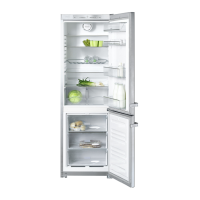


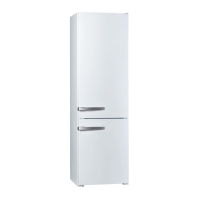


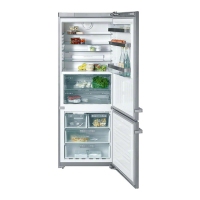
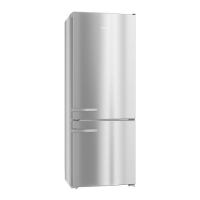
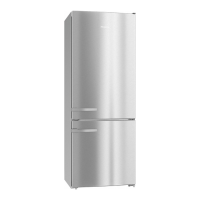
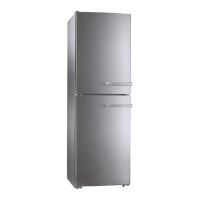

